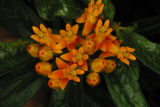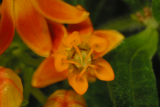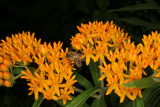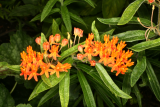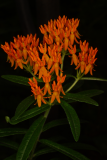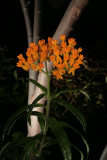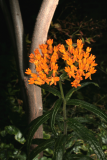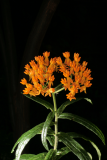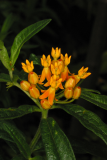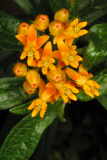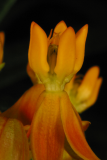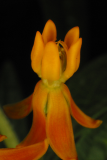Additional notes (click to expand)
Commemorative
Asclepias tuberosa is named for Asclepius, the Greek god of medicine (Aesculapius in the Roman pantheon), the son of Apollo. He probably existed around 600 BC, but became a Roman god in c. 295 BC. Apollo was the god who kept disease away and Telesphorus, the short person with the woolly hat who accompanies Asclepius in the Royal College of Physicians’ statue, was the god of convalescence. Asclepius was regarded as a ‘hands-on’ physician who intervened with drugs and surgery when a person was ill. His staff, with a single snake twined round it, is the symbol of medicine, and is used as the logo of the British Medical Association and the American Medical Association. The caduceus, two snakes twined round a winged staff, was given to Hermes, the messenger of the gods, by Apollo and is not a medical symbol, although it has been so used in error (Graf, 2009). The mythology of Asclepius is convoluted, and there are several versions. Ovid’s (AD 8) version was that his mother was Coronis, daughter of Phlegyas, king of the Lapiths. Apollo
killed her when he heard she was a lover to someone else. The baby Asclepius, delivered by caesarean section from the dead Coronis as she lay on her burning funeral pyre by the repentant Apollo, was brought up by the centaur Chiron (who also brought up Achilles qv). Asclepius became so skilled that he was able to revive the dead, and Zeus killed him with a bolt of lightning. One version states that this was at the request of Pluto, king of the Underworld, who had become worried that Asclepius might keep everyone alive so there would be no more souls to enter Hades.
Oakeley, Dr. Henry. (2012). Doctors in the Medicinal Garden. Plants named after physicians. Royal College of Physicians. p 26 et seq
link
Horticulture
Asclepias tuberosa is a hardy perennial in the family Apocyanaceae, bearing clusters of orange flowers on upright stems in summer. It prefers dry, fast-draining soils and grows well in the Medicinal Garden in the dappled shade of a plane tree. It has large tuberous roots, which do not like to be disturbed. (CB)
Oakeley, Dr. Henry. (2012). Doctors in the Medicinal Garden. Plants named after physicians. Royal College of Physicians. p. 29
link
Medicinal
Traditional Herbal Medicine Registration (THMR).
Orange-flowered milkweed, (for Aesculapius, the physician God of Medicine). Asclepias tuberosa was eaten like asparagus in Canada, and drunk as a cure for colic. From New England to Florida the root, powdered and administered in a spoonful of rum (or boiled in water which destroys most of the toxins), was used to treat pleurisy, pneumonia and rheumatism (and even to curb ‘hysteric passion’). It is a very poisonous plant, a fact taken advantage of by the caterpillars of the Monarch (Danaus) butterflies which use it as their food plant, rendering them completely unpalatable to predatory birds.
Austin, Daniel, F. (2004) Florida Ethnobotany. CRC Press.
The Latin name in Gerard (1633), Vincetoxicum Indianum (literally ‘Indian counter-poison’), was given to it by John White (who found it on one of the expeditions (1584–90) to settle Roanoke Island in what is now South Carolina,) because ‘the savages ... wherewith theie cure their wounds which they receave by the poisoned arroes of theire enemys’. One poison being an antidote to another was a familiar concept in European herbal medicine of that era. Asclepias tuberosa has also acquired the name ‘pleurisy root’ as it was used for lung infections, but because of its toxicity it is a banned substance.
Oakeley, Dr. Henry. (2012). Doctors in the Medicinal Garden. Plants named after physicians. Royal College of Physicians. p.29
link
Nomenclature
Other common names: butterfly root, butterfly weed, chieger flower, flux root, Indian paintbrush, Indian potato, orange root, pleurisy root, swallow root, tuber root, white root, wind root, windward root
The Royal Horticultural Society Horticultural Database, available at www.rhs.org.uk
Other use
Our plant first appeared in Gerard (1597), ‘called Wysanck by the savages’ or Vincetoxicum Indianum, Virginian Silk Grasse, and the silky seeds were made into undergarments for young maidens.
Oakeley, Dr. Henry. (2012). Doctors in the Medicinal Garden. Plants named after physicians. Royal College of Physicians. p.29
link
Toxicity
Asclepias tuberosa is the American Milkweed, and is one of the host plants of the caterpillar of the Monarch butterfly, Danaus plexippus. The sap is highly toxic, containing cardenolides related to digoxin. The caterpillars store it and it continues in the bodies of the butterflies, which makes them poisonous to eat. One bird, the Black-headed Grosbeak, Pheucticus melanocephalus, is not affected by this poison and feeds on the overwintering adults. The butterflies are capable of huge migrations, overwintering in the pine forests of Mexico and California.
Asclepias tuberosa has also acquired the name ‘pleurisy root’ as it was used for lung infections, but because of its toxicity it is a banned substance.
Oakeley, Dr. Henry. (2012). Doctors in the Medicinal Garden. Plants named after physicians. Royal College of Physicians. p. 26. 29
link
Geographical distribution
- Northern America, Eastern Canada
- Northern America, Mexico
- Northern America, North-Central U.S.A.
- Northern America, Northeastern U.S.A.
- Northern America, Northwestern U.S.A.
- Northern America, South-Central U.S.A.
- Northern America, Southeastern U.S.A.
- Northern America, Subarctic America
Asclepias tuberosa L.
Family: APOCYNACEAEGenus: Asclepias
Species: tuberosa L.
Common names: Butterfly Flower
Distribution summary: Northern America
Habit: Perennial
Hardiness: H5 - Hardy; cold winter
Habitat: Frequently on sandy soils
Garden status: Not currently grown
Flowering months: July, August, September
Reason for growing: Commemorative, medicinal, toxic, traditional herbal registration
.JPG)
.JPG)
.JPG)
